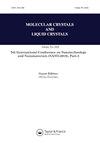New Technology for DNA Chips on a Microarray-Random Fluidic Self-assembly Method Using Hydrophobic Interaction
Molecular Crystals and Liquid Crystals Science and Technology. Section A. Molecular Crystals and Liquid Crystals
Pub Date : 2001-10-01
DOI:10.1080/10587250108030106
引用次数: 1
Abstract
Abstract In this paper, we describe a new approach for an arrangement of many kinds of DNAs on transducers to construct a DNA microarray. A high-density array of sensor probes was prepared by randomly distributing a mixture of particles immobilized with various DNAs. A process for immobilization of the DNAs was separated from the assembly of the particles. The particles were arranged on the chip pattern by random fluidic self-assembly, using hydrophobic interaction.基于微阵列的DNA芯片新技术-利用疏水相互作用的随机流体自组装方法
摘要本文描述了一种将多种DNA排列在传感器上以构建DNA微阵列的新方法。通过随机分布固定各种dna的颗粒混合物,制备了高密度传感器探针阵列。将dna的固定过程从颗粒的组装中分离出来。利用疏水相互作用,通过随机流体自组装将颗粒排列在芯片图案上。
本文章由计算机程序翻译,如有差异,请以英文原文为准。
求助全文
约1分钟内获得全文
求助全文
来源期刊
自引率
0.00%
发文量
0

 求助内容:
求助内容: 应助结果提醒方式:
应助结果提醒方式:


